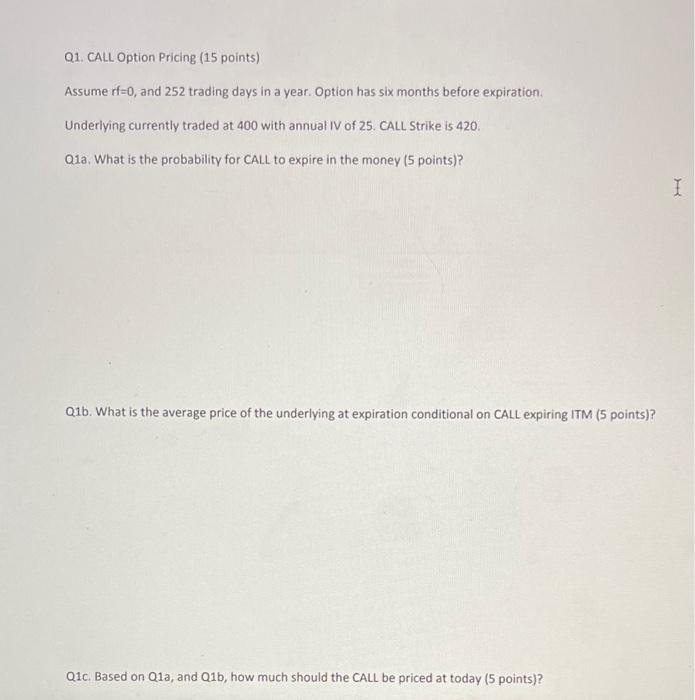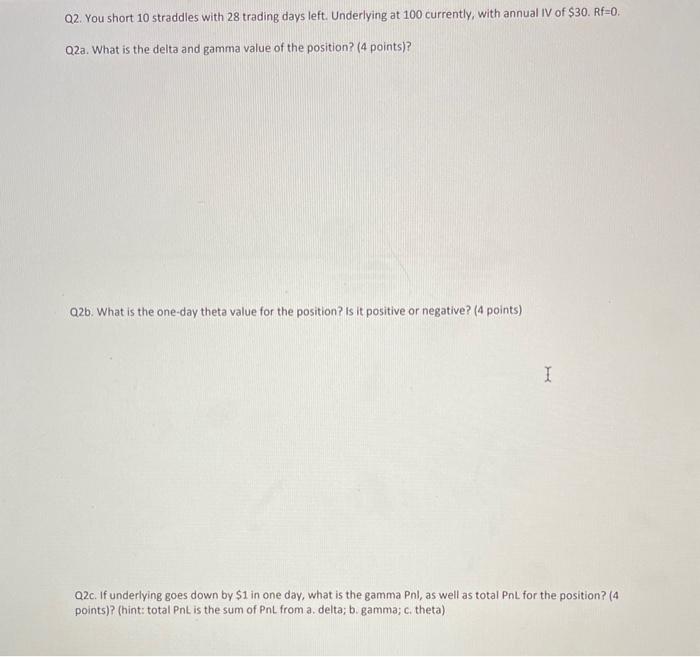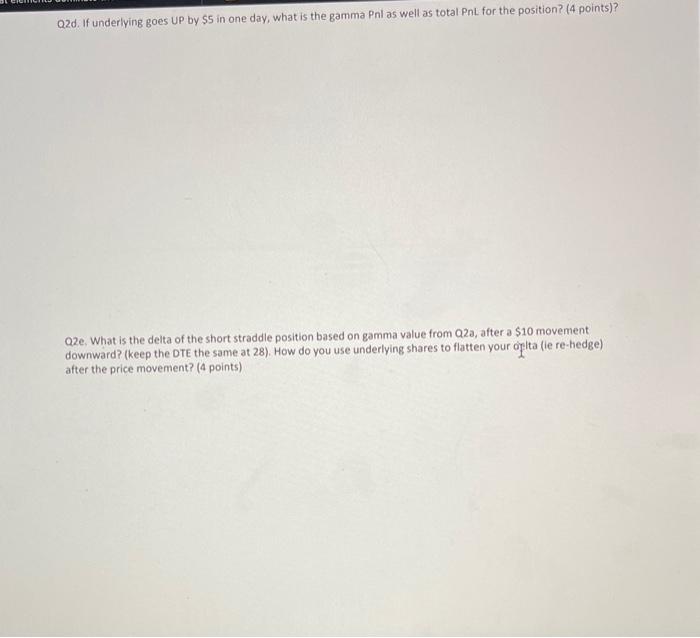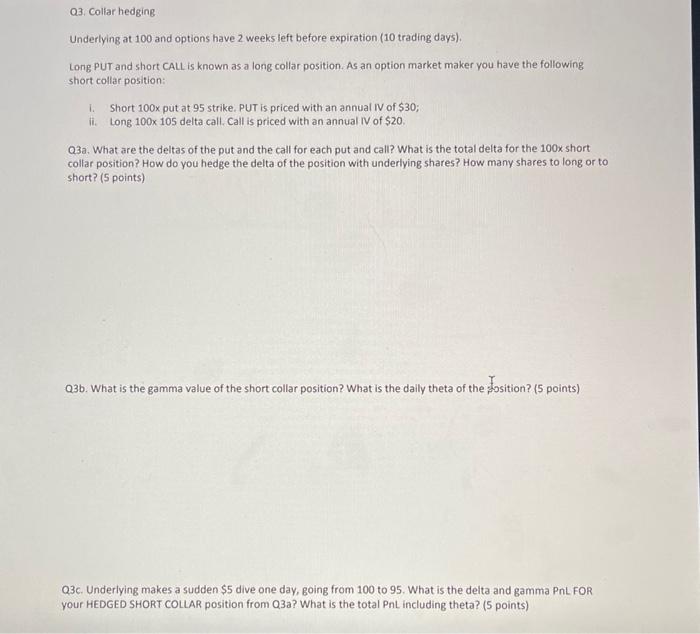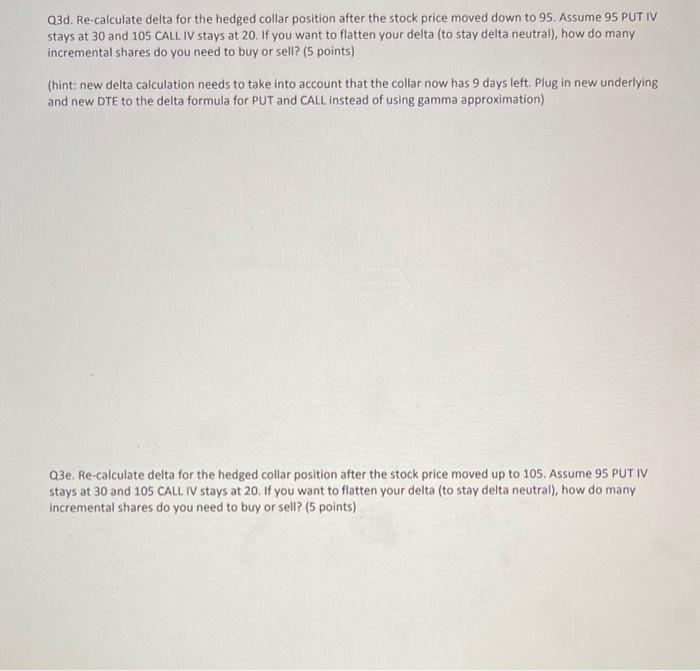Q1. CALL Option Pricing (15 points) Assume rf=0, and 252 trading days in a year. Option has six months before expiration. Underlying currently traded at 400 with annual IV of 25 . CALL Strike is 420 . Q1a. What is the probability for CALL to expire in the money ( 5 points)? Q1b. What is the average price of the underlying at expiration conditional on CALL expiring ITM ( 5 points)? Q1c. Based on Q1a, and Q1b, how much should the CALL be priced at today ( 5 points)? Q2. You short 10 straddles with 28 trading days left. Underlying at 100 currently, with annual IV of $30. Rf =0. Q2a. What is the delta and gamma value of the position? (4 points)? Q2b. What is the one-day theta value for the position? is it positive or negative? ( 4 points) Q2.c. If underlying goes down by $1 in one day, what is the gamma Pnl, as well as total PnL for the position? ( 4 points)? (hint: total PnL is the sum of PnL from a. delta; b. gamma; c. theta) Q2d. If underlying goes UP by $5 in one day, what is the gamma Pnl as well as total PnL for the position? (4 points)? Q2e. What is the delta of the short straddle position based on gamma value from Q2a, after a $10 movement downward? (keep the DTE the same at 28). How do you use underlying shares to flatten your ojelta (ie re-hedge) after the price movement? (4 points) Q3. Collar hedging Underlying at 100 and options have 2 weeks left before expiration ( 10 trading days). Long PUT and short CALL is known as a long collar position. As an option market maker you have the following short collar position: 1. Short 100 put at 95 strike. PUT is priced with an annual IV of $30; ii. Long 100105 delta call. Call is priced with an annual IV of $20. Q3a. What are the deltas of the put and the call for each put and call? What is the total delta for the 100 short collar position? How do you hedge the delta of the position with underlying shares? How many shares to long or to short? (5 points) Q3b. What is the gamma value of the short collar position? What is the daily theta of the josition? (5 points) Q3c. Underlying makes a sudden $5 dive one day, going from 100 to 95 . What is the delta and gamma PnLFOR your HEDGED SHORT COLLAR position from Q3a? What is the total PnL including theta? (5 points) Q3d. Re-calculate delta for the hedged collar position after the stock price moved down to 95 . Assume 95 PUT IV stays at 30 and 105 CALL. IV stays at 20 . If you want to flatten your delta (to stay delta neutral), how do many incremental shares do you need to buy or sell? (5 points) (hint: new delta calculation needs to take into account that the collar now has 9 days left. Plug in new underlying and new DTE to the delta formula for PUT and CALL instead of using gamma approximation) Q3e. Re-calculate delta for the hedged collar position after the stock price moved up to 105. Assume 95 PUT IV stays at 30 and 105 CALL IV stays at 20 . If you want to flatten your delta (to stay delta neutral), how do many incremental shares do you need to buy or sell? (5 points) Q1. CALL Option Pricing (15 points) Assume rf=0, and 252 trading days in a year. Option has six months before expiration. Underlying currently traded at 400 with annual IV of 25 . CALL Strike is 420 . Q1a. What is the probability for CALL to expire in the money ( 5 points)? Q1b. What is the average price of the underlying at expiration conditional on CALL expiring ITM ( 5 points)? Q1c. Based on Q1a, and Q1b, how much should the CALL be priced at today ( 5 points)? Q2. You short 10 straddles with 28 trading days left. Underlying at 100 currently, with annual IV of $30. Rf =0. Q2a. What is the delta and gamma value of the position? (4 points)? Q2b. What is the one-day theta value for the position? is it positive or negative? ( 4 points) Q2.c. If underlying goes down by $1 in one day, what is the gamma Pnl, as well as total PnL for the position? ( 4 points)? (hint: total PnL is the sum of PnL from a. delta; b. gamma; c. theta) Q2d. If underlying goes UP by $5 in one day, what is the gamma Pnl as well as total PnL for the position? (4 points)? Q2e. What is the delta of the short straddle position based on gamma value from Q2a, after a $10 movement downward? (keep the DTE the same at 28). How do you use underlying shares to flatten your ojelta (ie re-hedge) after the price movement? (4 points) Q3. Collar hedging Underlying at 100 and options have 2 weeks left before expiration ( 10 trading days). Long PUT and short CALL is known as a long collar position. As an option market maker you have the following short collar position: 1. Short 100 put at 95 strike. PUT is priced with an annual IV of $30; ii. Long 100105 delta call. Call is priced with an annual IV of $20. Q3a. What are the deltas of the put and the call for each put and call? What is the total delta for the 100 short collar position? How do you hedge the delta of the position with underlying shares? How many shares to long or to short? (5 points) Q3b. What is the gamma value of the short collar position? What is the daily theta of the josition? (5 points) Q3c. Underlying makes a sudden $5 dive one day, going from 100 to 95 . What is the delta and gamma PnLFOR your HEDGED SHORT COLLAR position from Q3a? What is the total PnL including theta? (5 points) Q3d. Re-calculate delta for the hedged collar position after the stock price moved down to 95 . Assume 95 PUT IV stays at 30 and 105 CALL. IV stays at 20 . If you want to flatten your delta (to stay delta neutral), how do many incremental shares do you need to buy or sell? (5 points) (hint: new delta calculation needs to take into account that the collar now has 9 days left. Plug in new underlying and new DTE to the delta formula for PUT and CALL instead of using gamma approximation) Q3e. Re-calculate delta for the hedged collar position after the stock price moved up to 105. Assume 95 PUT IV stays at 30 and 105 CALL IV stays at 20 . If you want to flatten your delta (to stay delta neutral), how do many incremental shares do you need to buy or sell? (5 points)
